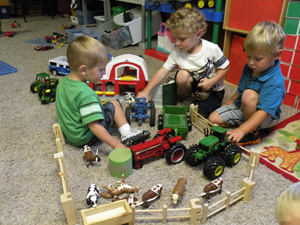G2106
Ages and Stages: 3-, 4- and 5-Year-Olds
Three-, four- and five-year-olds are active, imaginative, and increasingly independent. Learn about their developmental milestones and how you can help further develop their skills and confidence.
Lisa M. Poppe, LaDonna A. Werth, Jacqueline M. Guzman, Ruth E. Vonderohe, Gail L. Brand, Marilyn S. Fox, Mary E. Nelson, Leslie Crandall, Extension Educators
Tonia R. Durden, Early Childhood Extension Specialist
Rasheema J. Pitt, Graduate Assistant in Research and Extension
- Physical Development Milestones
- Cognitive Development Milestones
- Social and Emotional Development Milestones
- A Guide for the Parents and Caregivers of 3-, 4-, and 5-Year-Olds
- Resources
Three-, four-, and five-years-olds are active, imaginative, and eager to engage in the world around them. They are building skills and becoming more confident. At this stage, children have many “why” questions. Parents and caregivers can provide the preschooler with lots of support and a responsive and stimulating environment. As you help the 3- to 5-year-old child become more imaginative and confident, here are a few developmental milestones to consider.
Physical Development Milestones
- They can dress themselves, but may need help with ties, zippers, and buttons.
- Large motor skills are advancing. Children can walk in a straight line, hop, skip, and walk up and down stairs alternating legs. They can throw and catch a ball more precisely.
- Fine motor skills improve. Children can skillfully use a spoon, fork, and knife, use scissors to cut on a line, and can draw squares, circles, and a person with two to four body parts.
Cognitive Development Milestones
- Children learn basic colors, recognize numbers, and can count one to seven objects out loud.
- The alphabet should be familiar and some children may be able to print their name.
- They recognize familiar words in books and understand that books have a beginning, middle, and end. They also recognize symbols such as a stop sign.
- While 3-year-olds primarily engage in make believe play alone, four- and five-year-olds actively engage in fantasy and realistic play with peers.
|
Social and Emotional Development Milestones
- They begin to select friends and peer groups (Figure 1). They cooperate more with others, but sometimes exclude other children from social play experiences.
- Name calling, bragging, and showing off are also part of the learning curve.
- Pretending becomes more elaborate like playing fire station, school, or shopping.
A Guide for the Parents and Caregivers of 3-, 4-, and 5-Year-Olds
- Children need various activities available at all times. Items such as books, magazines, paper, markers, and toys help children increase their curiosity.
- Children at this age need to be taught to request, bargain, negotiate, and make amends.
- Provide a wide array of opportunities to express dramatic and creative interest. Teach children how to move their bodies to dramatize the opening of a flower or falling snow, leaves, or rain.
- Take questions children ask seriously. Talk to children about what happened and why. Parents and caregivers need to expect the truth from children, express clear expectations, and provide unconditional support.
- During this time the child’s sense of humor develops. Telling jokes and sharing wild stories becomes fun and exciting. They also believe in magic, which is why nightmares can be so terrifying. This is a critical time for parents to actively listen and encourage children’s display of multiple emotions.
- Create “I love you” rituals. This allows the 3-5 year old child to feel safe, loved, and assured.
- Parents should emphasize positive relationships. Children at this age enjoy making their own decisions, inventing games, and making and changing rules.
Resources
Books
Fun to Play, Ready to Learn Activity Guide (EB2), University of Nebraska–Lincoln Extension, 2007.
Developmental Profiles: Pre-Birth through Twelve by K. Eileen Allen and Lynn R. Marotz, published by Wadsworth, Belmont, 2010.
Ages and Stages for Caregivers, 4 Years (ASC-8-02), by Cheryl Barber, Kathy L. Reschke, and Mary F. Longo, Ohio State University, 2002.
Ages and Stages for Caregivers, 5 Years (ASC-9-02) by Cheryl Barber, Kathy L. Reschke, and Mary F. Longo, Ohio State University, 2002.
Websites
Center for Disease Control and Prevention: Infants and Toddlers, http://www.cdc.gov/parents/infants
Parenting and Just in Time Parenting Newsletter: www.extension.org/parenting Use code: NE10JITP
UNL Extension Child and Youth Development: http://www.extension.unl.edu/web/child
UNL Extension Building Better Children Facebook page: http://www.facebook.com/buildingbetterchildren
Zero to Three: National Center for Infants and Toddlers: www.zerotothree.org
This publication has been peer reviewed.
Visit the University of Nebraska–Lincoln Extension Publications website for more publications.
Index: Families
Childhood
Issued November 2011
